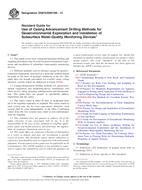Potřebujeme váš souhlas k využití jednotlivých dat, aby se vám mimo jiné mohly ukazovat informace týkající se vašich zájmů. Souhlas udělíte kliknutím na tlačítko „OK“.
ASTM D5872/D5872M-13
Standard Guide for Use of Casing Advancement Drilling Methods for Geoenvironmental Exploration and Installation of Subsurface Water-Quality Monitoring Devices
Automaticky přeložený název:
Standardní Příručka pro použití pouzdra pokroku Vrtací metody pro Geoenvironmental průzkum a instalace podpovrchových vod, kontroly kvality zařízení
NORMA vydána dne 1.8.2013
Informace o normě:
Označení normy: ASTM D5872/D5872M-13
Poznámka: NEPLATNÁ
Datum vydání normy: 1.8.2013
Kód zboží: NS-32902
Počet stran: 8
Přibližná hmotnost: 24 g (0.05 liber)
Země: Americká technická norma
Kategorie: Technické normy ASTM
Kategorie - podobné normy:
Anotace textu normy ASTM D5872/D5872M-13 :
Keywords:
casing-advancement drilling method(s), direct air rotary drilling, down-the-hole hammer (DTH), drill through casing hammer, drilling, groundwater, ICS Number Code 13.060.10 (Water of natural resources)
Doplňující informace
| Significance and Use | ||||||||||||||||||||
|
4.1 Casing advancement may be used in support of geoenvironmental exploration and for installation of subsurface water-quality monitoring devices in both unconsolidated and consolidated materials. Casing-advancement systems and procedures used for geoenvironmental exploration and instrumentation installations consist of direct air-rotary drilling utilizing conventional rotary bits or a down-the-hole hammer drill with underreaming capability, in combination with a drill-through casing driver. 4.1.1 Casing-advancement methods
allow for installation of subsurface water-quality monitoring
devices and collection of water-quality samples at any depth(s)
during drilling.
4.1.2 Other advantages of casing-advancement drilling methods include: the capability of drilling without the introduction of any drilling fluid(s) to the subsurface; maintenance of hole stability for sampling purposes and monitor-well installation/construction in poorly-indurated to unconsolidated materials. 4.1.3 The user of casing-advancement drilling for geoenvironmental exploration and monitoring-device installations should be cognizant of both the physical (temperature and airborne particles) and chemical (compressor lubricants and possible fluid additives) qualities of compressed air that may be used as the circulating medium. 4.2 The application of casing-advancement drilling to geoenvironmental exploration may involve soil or rock sampling, or in-situ soil, rock, or pore-fluid testing. The user may install a monitoring device within the same borehole wherein sampling, in-situ or pore-fluid testing, or coring was performed. 4.3 The subsurface water-quality monitoring devices that are addressed in this guide consist generally of a screened- or porous-intake device and riser pipe(s) that are usually installed with a filter pack to enhance the longevity of the intake unit, and with isolation seals and low-permeability backfill to deter the movement of fluids or infiltration of surface water between hydrologic units penetrated by the borehole (see Practice D5092). Inasmuch as a piezometer is primarily a device used for measuring subsurface hydraulic heads, the conversion of a piezometer to a water-quality monitoring device should be made only after consideration of the overall quality and integrity of the installation to include the quality of materials that will contact sampled water or gas. Both water-quality monitoring devices and piezometers should have adequate casing seals, annular isolation seals and backfills to deter communication of contaminants between hydrologic units. 1.1 This guide covers how
casing-advancement drilling and sampling procedures may be used for
geoenvironmental exploration and installation of subsurface
water-quality monitoring devices.
1.2 Different methods exist to advance casing for geoenvironmental exploration. Selection of a particular method should be made on the basis of geologic conditions at the site. This guide does not include procedures for wireline rotary casing advancer systems which are addressed in Guide D5786. 1.3 Casing-advancement drilling methods for geoenvironmental exploration and monitoring-device installations will often involve safety planning, administration and documentation. This guide does not purport to specifically address exploration and site safety. 1.4 The values stated in either SI units or inchpound units are to be regarded separately as standard. The values stated in each system may not be exact equivalents; therefore, each system shall be used independently of the other. Combining values from the two systems may result in non-conformance with the standard. 1.5 This standard does not purport to address all of the safety concerns, if any, associated with its use. It is the responsibility of the user of this standard to establish appropriate safety and health practices and determine the applicability of regulatory limitations prior to use. 1.6 This guide offers an organized collection of information or a series of options and does not recommend a specific course of action. This document cannot replace education or experience and should be used in conjunction with professional judgment. Not all aspects of this guide may be applicable in all circumstances. This ASTM standard is not intended to represent or replace the standard of care by which the adequacy of a given professional service must be judged, nor should this document be applied without consideration of a project's many unique aspects. The word “Standard” in the title of this document means only that the document has been approved through the ASTM consensus process. |
||||||||||||||||||||
| 2. Referenced Documents | ||||||||||||||||||||
|
Doporučujeme:
Aktualizace technických norem
Chcete mít jistotu, že používáte pouze platné technické normy?
Nabízíme Vám řešení, které Vám zajistí měsíční přehled o aktuálnosti norem, které používáte.
Chcete vědět více informací? Podívejte se na tuto stránku.




 Cookies
Cookies
